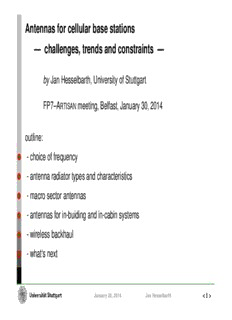
Antennas for cellular base stations — challenges, trends - ARTISAN PDF
Preview Antennas for cellular base stations — challenges, trends - ARTISAN
Antennas for cellular base stations — challenges, trends and constraints — by Jan Hesselbarth, University of Stuttgart FP7–A meeting, Belfast, January 30, 2014 RTISAN outline: - choice of frequency - antenna radiator types and characteristics - macro sector antennas - antennas for in-buiding and in-cabin systems - wireless backhaul - what‘s next < 1 > January 30, 2014 Jan Hesselbarth Antennas to provide coverage, throughput, adaptivity Different requirements for frequency, pattern, adaptivity, size, cost etc. macro cell mm-wave mesh backhaul Gbit Gbit hotspot Gbit hotspot hotspot micro cell < 2 > January 30, 2014 Jan Hesselbarth outline: - choice of frequency - antenna radiator types and characteristics - macro sector antennas - antennas for in-buiding and in-cabin systems - wireless backhaul - what‘s next < 3 > January 30, 2014 Jan Hesselbarth Choice of frequency Criteria for mobile cellular: antenna size, path loss, diffraction, bandwidth, Doppler low frequency cellular: high frequency cellular: - low path loss / large cells - high path loss / small cells - strong diffraction - weak diffraction - small Doppler shift - large Doppler shift - small bandwidth - larger bandwidth - large antennas - smaller antennas (cid:198) for coverage and mobility (cid:198) for increased throughput (cid:198) small throughput in rather small cells (450 MHz) & 700 – 1000 MHz 1700 – 2600 MHz Example: „NMT“ network in Skandinavia at 450 MHz: 25 km cell radius, few users (cid:198) congested in some cities as early as 1983 < 4 > January 30, 2014 Jan Hesselbarth Choice of frequency Criteria for wireless backhaul: path loss, bandwidth, atmospheric attenuation, licensing scheme ] 7 3 1 - 3 8 t r o p e r A I T N , e b e i L . J . H [ < 5 > January 30, 2014 Jan Hesselbarth Choice of frequency Criteria for wireless backhaul: path loss, bandwidth, atmospheric attenuation, licensing scheme (cid:198) long-distance hops (>10km) with raher low capacity at 6…20 GHz . dish diameter ~ 1…2 m (cid:198) medium-distance hops (3…10km) with high capacity (~ 100 Mbps) at 28…44 GHz . dish diameter ~ 0.6 m (cid:198) shortest-distance hops (<1km) with multi-GBps capacity at 60 GHz . dish diameter ~ 0.3m (cid:198) short-distance hops (<2km) with multi-GBps capacity at 71…86 GHz . dish diameter ~ 0.3m < 6 > January 30, 2014 Jan Hesselbarth outline: - choice of frequency - antenna radiator types and characteristics - macro sector antennas - antennas for in-buiding and in-cabin systems - wireless backhaul - what‘s next < 7 > January 30, 2014 Jan Hesselbarth Antenna radiator types and characteristics For most antennas with sectorial pattern (not: omnidirectional ones), a groundplane provides suppression of backward radiation and is used for mounting purposes. Radiators with groundplane: patch dipole over ground backed slot ° ° … all similar in gain (5…9 dBi) and in beamwidth (90 …140 ) < 8 > January 30, 2014 Jan Hesselbarth Antenna radiator types and characteristics - backed slot antennas: severe problems with bandwidth (cid:198) no relevant use - patch antennas: reasonable bandwidth requires very thick dielectric or stacked patches; efficiency and cost and weight requirements lead to mechanically tricky air dielectric (cid:198) limited use example: thick air dielectric patch (bandwidth~8%@|S |< –10dB) 11 ] t n e c u L - l e t a c l A [ < 9 > January 30, 2014 Jan Hesselbarth Antenna radiator types and characteristics - patch antennas: ] example: air dielectric stacked patch 5 9 9 1 (3 resonances — bandwidth h c e t ~19%@|S |< –10dB) r A 11 , s a n patch 2 n e t n A patch 1 h c t a feedline P d n slot & patches a slot in ground b d a o ground r B , l o i d r a G . E r] F. e n r, h e u h S c r + ü r Z e b F. feed patch 1 patch 2 feed Hu .- J [ [ < 10 > January 30, 2014 Jan Hesselbarth
Description: